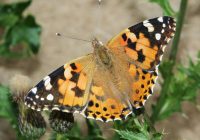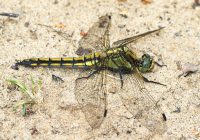Dr Phil Smith’s Wildlife Notes
July 2014
Another month of above average temperatures culminated in a heat wave with several days of 29oC, coupled with high humidity. The “orchid summer” continued, with later species, such as the Marsh Helleborine, putting on a good show in the dune-slacks, while Dune Helleborines flowered much earlier than usual and in high numbers. A favoured bank at Birkdale produced 57, rather than the usual dozen or so. As in July last year, I found a small population of Dune Helleborines west of Sands Lake, Ainsdale with unusual yellowish foliage and flowers, seemingly lacking in green pigment but otherwise perfectly healthy. The lake itself had three huge Goldfish, over a foot long, presumably released from an aquarium or garden pond.
On the first day of the month, Patricia Lockwood joined me to record Japanese Rose in the southern Birkdale frontals as part of the coastwide volunteer survey of this rapidly spreading garden-escape. As well as measuring many large patches of the prickly invader, we refound only known duneland colony of Spiny Restharrow. Also notable was a pair of Dark Green Fritillaries, the first Brown Hawker of the summer and lots of Common Darters, sheltering as usual behind the Green Beach Alders. I was also delighted to find a large bush of Green–leaved Willow, only the second individual of this hybrid (Osier × Purple Willow) I have seen on the coast.
Another botanical survey involved a study of the rare Sharp Club-rush at its only British locality in the Birkdale frontal dunes. Having become extinct at its original Ainsdale locality, the plant was reintroduced to Birkdale in 1990 from cultivated Ainsdale stock. I last studied it 10 years ago and was pleased to find that it has increased almost threefold.
Hightown dunes also support many uncommon plants, a mid-month visit being rewarded by the coastal sub-species roseata of the Hedge Bindweed with its attractive pink and white striped flowers in great abundance. I first spotted this colony in 1982 but it has never been so numerous before. It was also good to see a pair of Shelduck with 12 young on the adjacent Alt Estuary.
Butterflies also benefited from the warm weather, a highlight being the White-letter Hairstreak that Trevor Davenport and I found on the same date and at the same Ainsdale NNR locality as one in 2012. It was seen by several other people over the next few days, while others were reported at Crosby and Blundellsands. Later, we did a “Big Butterfly Count” for Butterfly Conservation on the same field, finding 64 individuals of seven species (including day-flying moths), the total being slightly down on last year’s.
Towards the end of the month, there was a spectacular hatch of Peacocks, reflected in my count of 50 on Creeping Thistle at Hightown. With them were a dozen Small Tortoishells, two Red Admirals and singles of Comma and Painted Lady; all the common “vanessids” in one go!
My annual dragonfly walk at Mere Sands Wood Nature Reserve attracted 20 enthusiasts in ideal conditions. We found eight species, about par for the course, including a splendid female Black-tailed Skimmer which posed nicely for photos, the males being more elusive as usual. However, the real dragonfly highlight of the month was a visit Trevor Davenport and I made to a friend’s Hillside garden, where his enormous pond produced as many species as Mere Sands Wood, including three superb Ruddy Darters and an obliging male Emperor. Our largest dragonfly, the latter species rarely perches, so it was a special treat when this individual finally obliged for photos.
Another garden dragonfly was an immature male Southern Hawker, a vision in emerald green, that Patricia Lockwood found in her kitchen. She kept it in the fridge overnight so I could photograph it the following morning, after which it soon warmed up and flew off in the direction of next door’s garden pond.




